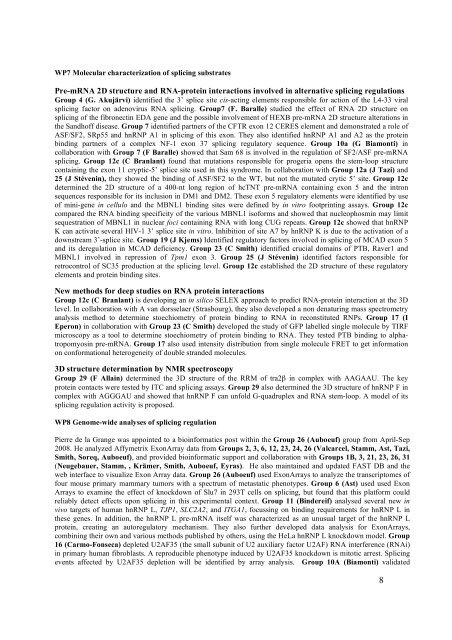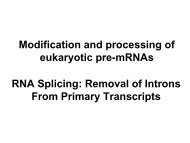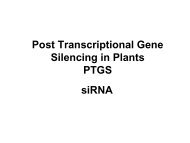You also want an ePaper? Increase the reach of your titles
YUMPU automatically turns print PDFs into web optimized ePapers that Google loves.
WP7 Molecular characterization of splicing substratesPre-mRNA 2D structure and RNA-protein interactions involved in alternative splicing regulationsGroup 4 (G. Akujärvi) identified the 3’ splice site cis-acting elements responsible for action of the L4-33 viralsplicing factor on adenovirus RNA splicing. Group7 (F. Baralle) studied the effect of RNA 2D structure onsplicing of the fibronectin EDA gene and the possible involvement of HEXB pre-mRNA 2D structure alterations inthe Sandhoff disease. Group 7 identified partners of the CFTR exon 12 CERES element and demonstrated a role ofASF/SF2, SRp55 and hnRNP A1 in splicing of this exon. They also identified hnRNP A1 and A2 as the proteinbinding partners of a complex NF-1 exon 37 splicing regulatory sequence. Group 10a (G Biamonti) incollaboration with Group 7 (F Baralle) showed that Sam 68 is involved in the regulation of SF2/ASF pre-mRNAsplicing. Group 12c (C Branlant) found that mutations responsible for progeria opens the stem-loop structurecontaining the exon 11 cryptic-5’ splice site used in this syndrome. In collaboration with Group 12a (J Tazi) and25 (J Stévenin), they showed the binding of ASF/SF2 to the WT, but not the mutated crytic 5’ site. Group 12cdetermined the 2D structure of a 400-nt long region of hcTNT pre-mRNA containing exon 5 and the intronsequences responsible for its inclusion in DM1 and DM2. These exon 5 regulatory elements were identified by useof mini-gene in cellulo and the MBNL1 binding sites were defined by in vitro footprinting assays. Group 12ccompared the RNA binding specificity of the various MBNL1 isoforms and showed that nucleophosmin may limitsequestration of MBNL1 in nuclear foci containing RNA with long CUG repeats. Group 12c showed that hnRNPK can activate several HIV-1 3’ splice site in vitro. Inhibition of site A7 by hnRNP K is due to the activation of adownstream 3’-splice site. Group 19 (J Kjems) Identified regulatory factors involved in splicing of MCAD exon 5and its deregulation in MCAD deficiency. Group 23 (C Smith) identified crucial domains of PTB, Raver1 andMBNL1 involved in repression of Tpm1 exon 3. Group 25 (J Stévenin) identified factors responsible forretrocontrol of SC35 production at the splicing level. Group 12c established the 2D structure of these regulatoryelements and protein binding sites.New methods for deep studies on RNA protein interactionsGroup 12c (C Branlant) is developing an in silico SELEX approach to predict RNA-protein interaction at the 3Dlevel. In collaboration with A van dorsselaer (Strasbourg), they also developed a non denaturing mass spectrometryanalysis method to determine stoechiometry of protein binding to RNA in reconstituted RNPs. Group 17 (IEperon) in collaboration with Group 23 (C Smith) developed the study of GFP labelled single molecule by TIRFmicroscopy as a tool to determine stoechiometry of protein binding to RNA. They tested PTB binding to alphatropomyosinpre-mRNA. Group 17 also used intensity distribution from single molecule FRET to get informationon conformational heterogeneity of double stranded molecules.3D structure determination by NMR spectroscopyGroup 29 (F Allain) determined the 3D structure of the RRM of tra2β in complex with AAGAAU. The keyprotein contacts were tested by ITC and splicing assays. Group 29 also determined the 3D structure of hnRNP F incomplex with AGGGAU and showed that hnRNP F can unfold G-quadruplex and RNA stem-loop. A model of itssplicing regulation activity is proposed.WP8 Genome-wide analyses of splicing regulationPierre de la Grange was appointed to a bioinformatics post within the Group 26 (Auboeuf) group from April-Sep<strong>2008</strong>. He analyzed Affymetrix ExonArray data from Groups 2, 3, 6, 12, 23, 24, 26 (Valcarcel, Stamm, Ast, Tazi,Smith, Soreq, Auboeuf), and provided bioinformatic support and collaboration with Groups 1B, 3, 21, 23, 26, 31(Neugebauer, Stamm, , Krämer, Smith, Auboeuf, Eyras). He also maintained and updated FAST DB and theweb interface to visualize Exon Array data. Group 26 (Auboeuf) used ExonArrays to analyze the transcriptomes offour mouse primary mammary tumors with a spectrum of metastatic phenotypes. Group 6 (Ast) used used ExonArrays to examine the effect of knockdown of Slu7 in 293T cells on splicing, but found that this platform couldreliably detect effects upon splicing in this experimental context. Group 11 (Bindereif) analysed several new invivo targets of human hnRNP L, TJP1, SLC2A2, and ITGA1, focussing on binding requirements for hnRNP L inthese genes. In addition, the hnRNP L pre-mRNA itself was characterized as an unusual target of the hnRNP Lprotein, creating an autoregulatory mechanism. They also further developed data analysis for ExonArrays,combining their own and various methods published by others, using the HeLa hnRNP L knockdown model. Group16 (Carmo-Fonseca) depleted U2AF35 (the small subunit of U2 auxiliary factor U2AF) RNA interference (RNAi)in primary human fibroblasts. A reproducible phenotype induced by U2AF35 knockdown is mitotic arrest. Splicingevents affected by U2AF35 depletion will be identified by array analysis. Group 10A (Biamonti) validated8







